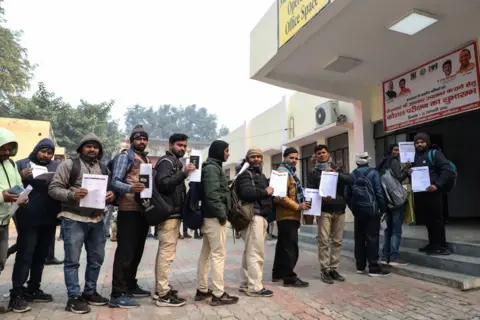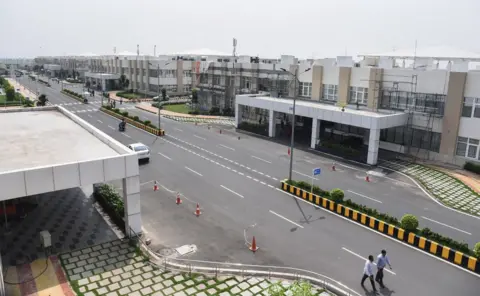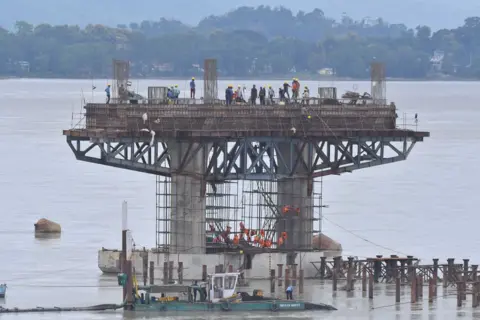[ad_1]
 Getty Images
Getty ImagesIndia’s Finance Minister Nirmala Sitharaman has presented her coalition government’s first budget after a slim election victory saw the governing Bharatiya Janata Party (BJP) lose its outright majority in parliament.
The new spending plan has replaced a stop-gap interim budget that came into effect from 1 April.
The budget announcements clearly indicate a shift in priorities for Prime Minister Narendra Modi’s new dispensation, with ramped up allocations for rural development, skilling, jobs and agriculture.
Here are the six key takeaways from India’s budget:
Bad news for investors
The budget increased tax on long-term capital gains on all financial and non-financial assets to 12.5% from 10%. Assets held for over a year are considered long term.
Short-term capital gains will now be taxed at 20% instead of 15%.
The budget has also increased the securities transaction tax on derivatives trading.
This was widely expected, with the Economic Survey released a day earlier raising red flags about rising speculation and growing participation of retail investors in Indian equity markets.
 Getty Images
Getty ImagesA $24bn jobs plan
Ms Sitharaman has announced three new schemes to address India’s chronic employment challenge that will cost the government 2tn rupees ($24bn; £18.5bn) over the next five years.
First-time job entrants in the formal sector will receive a direct cash transfer equivalent to their monthly salary (or up to a maximum of 15,000 rupees) in addition to their first month’s pay.
Additionally, two more programmes have been announced to boost manufacturing jobs through which the government will provide employment-linked incentives to both employees and employers.
Tax relief for start-ups, middle classes and foreign corporates
The country’s burgeoning start-up ecosystem will have something to cheer about, with an angel tax levied on capital raised by private companies now abolished.
Minor tweaks were also announced to personal income taxes, with expected savings of up to 17,500 rupees ($209; £162) in outgo for people who opt for the new tax regime.
Corporate tax on foreign companies has also been reduced from 40% to 35% to promote investments.
 Getty Images
Getty ImagesA budget for the allies
The budget sought to satisfy spending demands from the BJP’s two key regional allies – Janata Dal (United) of the northern state of Bihar and Telugu Desam Party of southern Andhra Pradesh state – which hold 28 seats in India’s lower house.
The finance minister announced financial support of 150bn rupees for the development of Andhra Pradesh’s capital, with a promise for more money in the coming years.
A slew of new airport, road and power projects were sanctioned in Bihar.
Reduced budget deficit
The budget has set a new, reduced target for its fiscal deficit – the amount by which spending exceeds revenue – at 4.9% for this financial year, below the 5.1% announced earlier.
The number is closely watched by ratings agencies and has a direct bearing on interest rates.
A significant dividend payout of more than $25bn from the country’s central bank has enabled the government to reduce its deficit without cutting expenditure significantly.
 Getty Images
Getty ImagesCapex unchanged
The outlay on state-led capital expenditure on infrastructure creation has remained unchanged from the $134bn announced in the interim budget.
“It is clear the focus has now become more diversified to other areas like employment, small businesses and social welfare,” said Shubhada Rao, economist and founder of QuantEco Research.
The budget is clearly more redistributive in nature, she added, and while there’s not necessarily “more direct cash in the hands of people”, announcements such as salary credits to new employees and minor tax tweaks could improve disposable incomes.
India’s finance ministry expects the economy to grow between 6.5% and 7% in the financial year ending March 2025 – lower than 8.2% last year and below forecasts from the central bank as well as multilateral bodies like the International Monetary Fund and the Asian Development Bank.
Follow BBC India on YouTube, Instagram, Twitter and Facebook
[ad_2]
Source link




